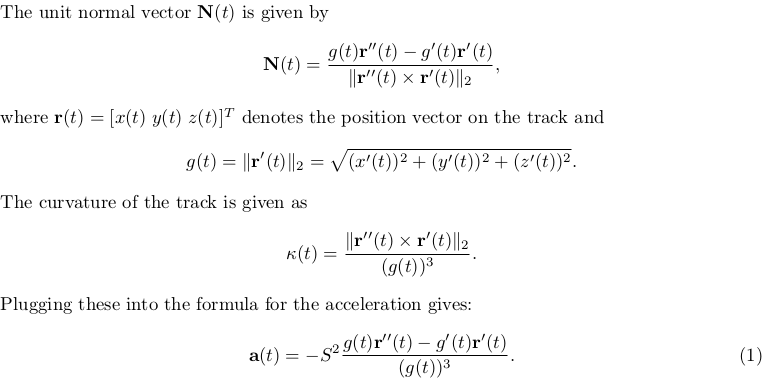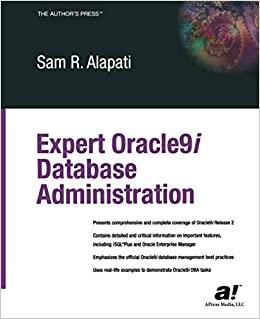Question
%%%%%%MATLAB%%%%%%% For this problem, you will use the spline function to construct a closed-loop roller coaster track. On this track, youll plot vectors indicating the
%%%%%%MATLAB%%%%%%%
For this problem, you will use the spline function to construct a closed-loop roller coaster track. On this track, youll plot vectors indicating the strength of the centripetal force you would feel as you go around the track. To construct the track, download the file roller coaster.dat(see below for contents). This file contains a list of points, (t, x(t), y(t), z(t)) for the parameterized curve describing the track. Note that the data in this file has been padded at the beginning and end so as to produce a better result when used with the spline function. The parameter range you should use when evaluating the curve in the work below is 1 t 11.Assume that the cars on this roller coaster are attached to a cable on the tracks, and this cable pulls the cars around the roller coaster track at constant speed S = 60m/s. Also, assume that the cars are always oriented outwards in the direction of the normal vector to the curve. Sitting in the car, you wont experience any acceleration in the direction tangent to the tracks, but you will experience acceleration as you bend around the curves. The acceleration required to keep you and the roller coaster attached to the track is the centripetal acceleration and can be described as  (a) Compute the components x(t), y(t), and z(t) of a parametric spline that fits the data in the roller coaster.dat file using spline. Plot the parametric spline together with the points defining the roller coaster using the plot3 function and the parameter range 1 t 11. This curve should resemble a roller coaster.
(a) Compute the components x(t), y(t), and z(t) of a parametric spline that fits the data in the roller coaster.dat file using spline. Plot the parametric spline together with the points defining the roller coaster using the plot3 function and the parameter range 1 t 11. This curve should resemble a roller coaster.
contents of roller_coaster.dat
-3.0000000000000000e+00 5.5555555555555486e+01 1.6432748538011685e+02 8.4234470182877303e+01 -2.0000000000000000e+00 -8.0116959064327546e+01 1.5964912280701742e+02 4.9972597362134451e+01 -1.0000000000000000e+00 -1.0467836257309943e+02 4.7368421052631561e+01 4.3902488765921390e+01 0.0000000000000000e+00 -1.3040935672514621e+02 -5.7894736842105260e+01 1.4905708324568812e+01 1.0000000000000000e+00 -1.3157894736842104e+02 -1.2456140350877189e+02 4.6371356064551115e+01 2.0000000000000000e+00 -4.1520467836257353e+01 -1.7017543859649118e+02 5.8981748960474313e+01 3.0000000000000000e+00 1.0233918128654960e+02 -1.6315789473684208e+02 1.8717207053983863e+01 4.0000000000000000e+00 1.6666666666666652e+02 -6.6081871345029242e+01 6.1133014663795151e+01 5.0000000000000000e+00 1.6666666666666652e+02 6.8421052631578902e+01 5.1941981368346042e+00 6.0000000000000000e+00 1.4561403508771917e+02 1.5146198830409350e+02 5.7572694845372126e+01 7.0000000000000000e+00 5.5555555555555486e+01 1.6432748538011685e+02 8.4234470182877303e+01 8.0000000000000000e+00 -8.0116959064327546e+01 1.5964912280701742e+02 4.9972597362134451e+01 9.0000000000000000e+00 -1.0467836257309943e+02 4.7368421052631561e+01 4.3902488765921390e+01 1.0000000000000000e+01 -1.3040935672514621e+02 -5.7894736842105260e+01 1.4905708324568812e+01 1.1000000000000000e+01 -1.3157894736842104e+02 -1.2456140350877189e+02 4.6371356064551115e+01 1.2000000000000000e+01 -4.1520467836257353e+01 -1.7017543859649118e+02 5.8981748960474313e+01 1.3000000000000000e+01 1.0233918128654960e+02 -1.6315789473684208e+02 1.8717207053983863e+01 1.4000000000000000e+01 1.6666666666666652e+02 -6.6081871345029242e+01 6.1133014663795151e+01
The unit normal vector N(t) is given by N(t) =-11 g(t)r"(t)- g'(t)r'(t) r"(t) r"(t)112 ll where r(t) = [x(t) y(t) z(t)]T denotes the position vector on the track and g(t) = llr'(t)ll,-V(z'(t))2 + (y'(t))2 + (z'(t))2. The cur vature of the track is given as ,(t) x r'(t)112 (g(t))3 n(t) = Plugging these into the tormula for the acceleration gives: ait) =-S2 g(t)r'"(t)-g"(t)r'(t) g(t))3
Step by Step Solution
There are 3 Steps involved in it
Step: 1

Get Instant Access to Expert-Tailored Solutions
See step-by-step solutions with expert insights and AI powered tools for academic success
Step: 2

Step: 3

Ace Your Homework with AI
Get the answers you need in no time with our AI-driven, step-by-step assistance
Get Started


